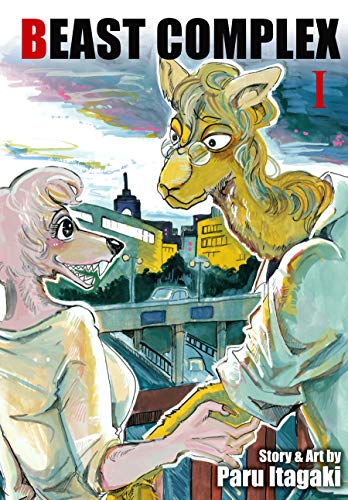Manga Review: Beast Complex I by Paru Itagaki
As it happens, Paru Itagaki has loved drawing animals and animal-people since she was a child. So it’s no surprise that when she started professional manga creation, she chose to write about a world where various animal people lived together and tried to have a civilization. Before she landed a long-term contract for Beastars, (the anime adaptation of which I’ve reviewed), she started a series of linked short stories under the blanket title “Beast Complex.”

Each story in this first volume is titled after two people’s animal identities, and features a different aspect of people’s relationships with each other.
“The Lion and the Bat” features Raul, who is the student council president and good at both academics and athletics. He’s driven to succeed, but that leaves him vulnerable to teacher “requests.” In this case, his nocturnal classmate Azmo has not been to school in some time and the teacher asks Raul to try to convince the bat to start attending again.
As it turns out, Azmo has been having a rough time, and has reason to distrust lions. Raul must set aside his pride to help Azmo, and learns that sometimes you don’t get the results you want, even if the outcome is positive for those you reach out to.
“The Tiger and the Beaver” is set in elementary school. Gon and Mogu are ten, and lifelong friends. But soon their bodies will change, and Gon will become an enormous carnivore, while Mogu won’t get much larger. That’s why their school separates the dorms. But Gon wants to stay friends with Mogu. When they witness bullying by older students, the boys know they have to stop it, even if it risks both their safeties.
“The Camel and the Wolf” is a tale of a burnt-out journalist about to file his last story about “street devourers” (carnivores who eat herbivores right there in public), and the beautiful white wolf he meets. Can he learn from her why some carnivores are murderous?
“The Kangaroo and the Black Panther” takes place in a crime-ridden city with declining tourism. The kangaroo runs a hotel that’s seen better days, and he’s startled when a teenage black panther girl asks for a room. She’s either in trouble, or is trouble, but he can hardly claim not to have any vacancies. Notably, the kangaroo has a gun.
“The Crocodile and the Gazelle” focuses on the long-running cooking show “Happy Happy Cooking.” Luna has been the assistant chef for five years, and knows that the ratings have been steadily dropping, but is still upset when the cattle host retires in favor of Benny, who’s a culinary scientist…and a seven foot tall saltwater crocodile. Can this odd couple learn to work together and save the show from cancellation?
“The Fox and the Chameleon” brings us back to junior high school. The fox is being bullied by her fellow fox classmates; the only person who she can get along with is a shy chameleon boy. (Unlike real life, chameleons can effectively become invisible just standing in the middle of nowhere.)
As I’ve mentioned before, using anthropomorphic animals allows the writer to talk about issues like prejudice and social injustice without directly mapping them on real-life racism or ethnic divides. The kangaroo can certainly be thought of as an Australian expatriate and the black panther girl as of African descent, but they aren’t necessarily those categories. Carnivore vs. herbivore makes for a very different vibe in the social confrontations.
On the other hand, the similarities between our Earth’s culture and theirs sometimes weaken the suspension of disbelief. (The author notes this in her end omake; she’s of the opinion that you shouldn’t overthink it.)
The art makes it easy to tell even characters of the same species apart–look for the Legoshi cameos!
A couple of the stories come across a bit trite, but I think younger readers will still find them fresh.
Recommended for furry fans, and people who enjoyed Beastars.
And hey, there’s a second season of the cartoon!

